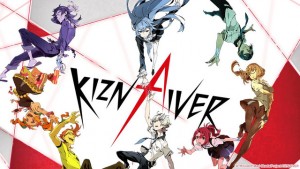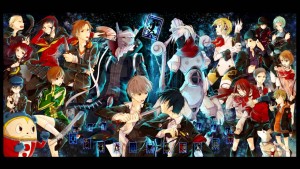Kiznaiver Review – Would You Share Someone’s Pain?
 While “Kill la Kill” is definitely a very “love it or hate it” kind of show, in the same vein as “Attack on Titan”, it served the purpose of putting its creator, studio Trigger, on the map, and making them one of the most recognizable names in anime. As such, when it was announced that they were working on a new anime that would air for a 12-episode run in 2012, you can bet that all eyes were on it as the starved fans waited to dig their teeth into whatever weird-but-deeper-than-expected adventure they’d be presented with next. Upon its release, “Kiznaiver” immediately became the stand-out anime of the season, with many praising its premise and characters before quickly… forgetting all about it and moving on to other things. Surprisingly, “Kiznaiver” neither became a classic nor was despised by fans, so… Is it good, or is it bad? Let’s get to the bottom of it together!
While “Kill la Kill” is definitely a very “love it or hate it” kind of show, in the same vein as “Attack on Titan”, it served the purpose of putting its creator, studio Trigger, on the map, and making them one of the most recognizable names in anime. As such, when it was announced that they were working on a new anime that would air for a 12-episode run in 2012, you can bet that all eyes were on it as the starved fans waited to dig their teeth into whatever weird-but-deeper-than-expected adventure they’d be presented with next. Upon its release, “Kiznaiver” immediately became the stand-out anime of the season, with many praising its premise and characters before quickly… forgetting all about it and moving on to other things. Surprisingly, “Kiznaiver” neither became a classic nor was despised by fans, so… Is it good, or is it bad? Let’s get to the bottom of it together!
The series is set in a near-futuristic city and centers on a small group of classmates who find themselves kidnapped by a mysterious organization and forced to participate in an experiment. Don’t worry, the series is a lot more cheerful and upbeat than something like “Danganronpa”, as the experiment doesn’t involve any physical harm coming to them… At least none that is caused by the organization. Instead, the teenagers are turned into Kiznaivers – people with a mental and physical connection who can share each other’s pain. If one of them is punched in the face, all six of them feel the pain of being punched in the face. Their primary task is to survive until the end of the summer, which is when they’ll stop being Kiznaivers and can go back to being normal students again.
Now, let me say from the beginning that the premise is AWESOME! Sure, the idea of a cast of characters being brought together by something is used in pretty much every single anime series ever, but this time the cast has a literal connection to each other that causes them to watch out for each other and help their fellow Kiznaivers whenever they can. Keep in mind that, one exception aside, most of the Kiznaivers are complete strangers despite being in the same class, so the experiment acts as the push they need to truly bond and become friends, which is fascinating to watch. Another thing I need to point out is the animation, which is absolutely stellar. I mean, geez, just look at this opening – so much creativity in just 90 seconds! Within the series itself, the character designs are great, the animation is fluid and smooth, and the colors pop out quite nicely. It’s a beautiful anime to just watch! Unfortunately, that’s about where the good points end.
A lot of praise went to the characters, but honestly? Most of them are just stereotypes. Main character Katsuhira is your standard quiet protagonist with a mysterious past that every woman seems to love anyway – there’s nothing new under the sun. Chidori is the unlucky childhood friend with a crush on Katsuhira who is too embarrassed to admit it. Tenga is the big dude who’s not that smart and loves to fight, but has a big heart. Yuta is the popular pretty boy who, um… Did something, I guess. I don’t know, I don’t remember much about Yuta. The best characters are undoubtedly Nico and Maki, who are still stereotypes, don’t get me wrong, but they’re also a bit of a subversion. At first, Nico seems like a very typical cloudcuckoolander, with her energetic over the top reactions, the fact that she still believes in fairies despite being in high school and her very unique fashion sense (seriously, what is wrong with her hair), but it’s quickly revealed that this is just a persona she built for herself because she didn’t want people to think of her as the spoiled rich girl. Maki, on the other hand, seems like the typical kuudere who refuses to open up to people, but honestly, this behavior stems from some very real trauma she sustained, and there are numerous hints pointing towards the idea that she might have Asperger’s, which further helps to explain her behavior. Sadly, not even Nico and Maki can save this otherwise very boring and typical cast of characters.
Another thing that stands against “Kiznaiver” is just how many missed opportunities it has. As I said, the premise is fantastic, but unfortunately it – much like the premise of “Sword Art Online” – is better developed in your head than on the screen. While there are certainly moments in which the anime takes advantage of its premise in unique ways (asking questions such as “what if a Kiznaiver is physically unable to feel pain”, or “what if a Kiznaiver is a masochist”), a lot of interesting ideas remain unexplored. Half of the Kiznaivers are girls, so what happens when they get their periods? Seeing the guys struggle with the kind of pain that girls need to bear every month would’ve made for some pretty fun comedy, and more importantly, it would’ve deepened the characters’ understanding of each other. Or what if one of the characters was sick and required painful treatments or even a surgery? It might have been interesting to make one of the cast members diabetic and see the cast react to the daily insulin injections. I could go on and on, but my point is that “Kiznaiver” could have done a LOT more with its premise.
Instead of just creating some interesting characters and setups and letting them free into this world, “Kiznaiver” feels the constant need to literally force situations on us. Throughout the summer the organization behind the Kiznaivers continuously place them in various experiments and setups in order to test out various features of the Kiznaiver program, and honestly, I feel like it would’ve been way better if those results were achieved naturally. For example, in one episode the group is chased by murderous mascots controlled by the organization, with the hopes that they would be split up into pairs which could form romantic attractions so that the effects of pain from heartbreak can be studied. And I’m just sitting there thinking… “Could you have a less natural way of shipping your characters?” Instead of just letting the relationships grow gradually due to subtle character moments, “Kiznaiver” seems intent on picking up a few canon couples and just shoving them down the viewer’s throat as forcefully as possible in scenarios like the one I explained above. And, of course, at the end of the series, almost everyone ends up with someone, tying everything with a nice little bow. And while in any other series two characters finally ending up together is seen as a climax, here my reaction was more along the lines of “Meh, whatever.”
If the premise of “Kiznaiver” sounds interesting to you, then maybe the show is worth a watch just for that alone. Just be wary of the fact that it’s not a masterpiece, and will likely be forgotten within the next few years. Enjoy it for what it is if you can, and if you can’t, don’t worry – it’s not that long, anyhow. And besides, if push comes to shove, “Kiznaiver” is a fantastic anime to test out the 3 episode rule with. If you’re interested, watch the first 3 episodes and see if it grabs you. If it doesn’t, the remainder probably won’t either.

 Hey, remember how last time I said I was going to go into some articles about fan-favorite franchise “Shin Megami Tensei: Persona” (which I’m going to refer to from now on simply as “Persona” in an attempt to shave off a couple hundred words from having to constantly write the full names of the games)? Well, here I am, ready to keep my promise! While “Shin Megami Tensei” is still kind of a niche franchise that only JRPG aficionados have any real interest in, its “Persona” spinoff has grown into a cultural phenomenon. Nobody thought that a game that is so deeply rooted in Japanese culture, philosophy and mythology could be successful worldwide – in fact, when released overseas, the first “Persona” was majorly overhauled for an American audience, with changed names and locales to make it more Western. Neither the first nor second games were really big hits on the original PlayStation, but when “Persona 3” hit on PS2… Boy oh boy.
Hey, remember how last time I said I was going to go into some articles about fan-favorite franchise “Shin Megami Tensei: Persona” (which I’m going to refer to from now on simply as “Persona” in an attempt to shave off a couple hundred words from having to constantly write the full names of the games)? Well, here I am, ready to keep my promise! While “Shin Megami Tensei” is still kind of a niche franchise that only JRPG aficionados have any real interest in, its “Persona” spinoff has grown into a cultural phenomenon. Nobody thought that a game that is so deeply rooted in Japanese culture, philosophy and mythology could be successful worldwide – in fact, when released overseas, the first “Persona” was majorly overhauled for an American audience, with changed names and locales to make it more Western. Neither the first nor second games were really big hits on the original PlayStation, but when “Persona 3” hit on PS2… Boy oh boy.